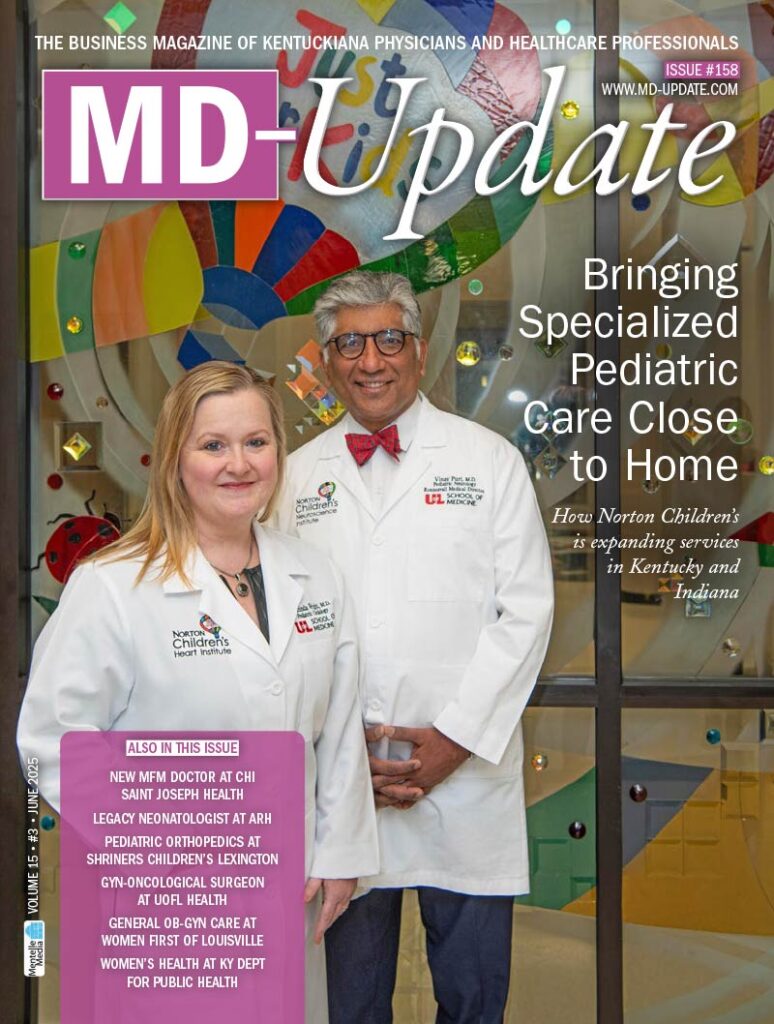BARDSTOWN For Kristie Paris, MD, radiation oncology may seem a far cry from her original career path in theatre, but in it, she has found her calling. Her initial interest in the healthcare field led Paris to a diploma from the Norton School for Nursing and a BSN in nursing. But, she did not stop there, pursuing a medical degree from the University of Louisville, where she also taught and practiced for 23 years. After retiring as a professor emeritus, Paris went into private practice, and then subsequently took positions at both Norton Healthcare and the University of Kentucky. In August of this year, Paris joined the Flaget Cancer Center in Bardstown, part of KentuckyOne Health.
In her three decades in the field, Paris has witnessed a multitude of changes. When she originally began administering radiation, nearly every treatment took six to seven weeks. She states, “You did get to spend time, get to know your patients, and take care of your patients. And, I enjoyed that. That’s why I chose radiation oncology.”
But, to the benefit of the patients, treatment time is steadily decreasing. This includes breast cancer treatment, which used to be at least six to seven weeks. Now, five weeks is the average. Paris explains, “Because we can be more precise, it is allowing us to cut the time down, which is good.” This precision is owed to advances in radiation technology, especially with the proliferation of computed tomography (CT) guided procedures.
Of the current state of radiation oncology, Paris says, “It has become a very highly technical field now. You have to be able to think 3-D and 4-D all the time, in order to cover tumors and protect normal tissue.” As a “free-standing radiation center,” the Flaget Cancer Center utilizes the latest technology by using an Elekta treatment delivery system, which has the capability of issuing most treatments. The Elekta can deliver modulated radiation, image-guided radiation, and has energy capabilities of 6 MV photon to 18 MV photon, as well as an electron beam. The center does not provide stereotactic radiation at this time.
“You can get the full gamut here, unlike some places where they do not have the higher energies or capabilities. Our treatment planning is all CT-based, and we work with the University of Louisville in their dosimetry and physics program. It allows us to merge other diagnostic tools into our treatment planning.” The goal is to use the combination of CT scans, PET scans, and MRIs for more precise localization of the tumor versus normal tissue. “That allows us to give better doses to the tumor and a lower dose to normal tissue, decreasing the side effects and long-term complications from treatment and increasing our control and cures,” says Paris.
This multidisciplinary approach extends to Flaget’s tumor boards, which consist of the participating surgeon, medical oncologists, nurses, and representatives from social services, the pharmacy, and the chaplaincy, who meet and discuss all prospective cases. Paris feels having everyone who is a player in the patient’s care present “gives you a better perspective, so you know how to individualize things.”
The goal is to customize treatments based on the very specific needs of each patient. This is especially helpful where breast cancer is concerned. Now, women have several options depending on the anatomy and type of disease. Patients undergoing breast conserving therapy after a lumpectomy may be administered a one-week course of partial breast radiation or a three-week course of hypofractionation to the whole breast. For those who have undergone an elective mastectomy, radiation may also be employed if the tumor was large and many of the lymph nodes are positive. Also, patients who are diagnosed with breast cancer through a needle biopsy may choose to undergo neoadjuvant chemotherapy to shrink a tumor prior to beginning breast conserving therapy. Or, if one has a poor prognostic tumor, they may be treated upfront systemically. Paris stresses, “Everything is custom-made for the patient, because Patient A is not Patient B is not Patient C.”
Paris also believes that, “As a radiation oncologist, you have to be involved in the clinic. If a patient walks in to me after being treated for one thing, I still want to make sure they get their routine mammograms, their routine colonoscopies, and things like this.” She adds, “The important thing about getting a mammogram is if you can pick something up while it’s a precancer, an in situ, which is a stage 0, those should be virtually 98 percent curable.”
To further spread the message about early detection, Paris travels to high schools to teach young women the importance of making self-examinations a part of their routine. “If you can teach girls how to examine their breasts, they’ll get to know their breasts and notice differences.”
Another way to individualize a patient’s plan is through the addition of palliative care. “Palliative medicine is another thing on the forefront that is going to help all patients, not just cancer patients. But, especially cancer patients.” In addition to longevity, now, radiation oncologists are considering quality of life. After finding out a patient’s goals for the upcoming months or years, assessing the amount of suffering they will endure to meet those goals, and how much medicine they are willing to take, treatment can vary.
As a radiation oncologist, she urges physicians, “Don’t be afraid to talk to patients about their cancer risks and ask about cancer history. And, if you find a patient has a strong family history, send them to genetics and let the geneticist find out if they could have a high-risk situation.” Because the bottom line is, “The earlier you can diagnose a cancer, the better the patient’s chances are in surviving and having longevity.”
The earlier you can diagnose a cancer, the better the patient’s chances are in surviving and having longevity.— Dr. Kristie Paris





